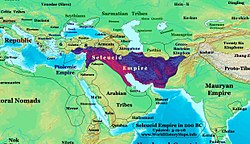Seleucid Empire
The Seleucid Empire was a Hellenistic (or Ancient Greek) successor state of Alexander the Great's empire. At its greatest extent, the Empire covered areas such as central Anatolia, the Levant, Mesopotamia, Persia, Turkmenistan, Pamir and the Indus Valley.
Seleucid Empire | |||||||||||||||||||
|---|---|---|---|---|---|---|---|---|---|---|---|---|---|---|---|---|---|---|---|
| 312 BC–63 BC | |||||||||||||||||||
 The empire at its greatest extent and on the eve of the death of Seleucus I, 281 BC | |||||||||||||||||||
| Capital | Seleucia (305–240 BC) Antioch (240–63 BC) | ||||||||||||||||||
| Common languages | Greek(official)[1] Persian Aramaic[1] | ||||||||||||||||||
| Religion | Olympianism Babylonian religion[2] Zoroastrianism | ||||||||||||||||||
| Government | Monarchy | ||||||||||||||||||
| Basileus | |||||||||||||||||||
• 305–281 BC | Seleucus I (first) | ||||||||||||||||||
• 65–63 BC | Philip II (last) | ||||||||||||||||||
| Historical era | Hellenistic period | ||||||||||||||||||
• | 312 BC | ||||||||||||||||||
| 301 BC | |||||||||||||||||||
| 192–188 BC | |||||||||||||||||||
| 188 BC | |||||||||||||||||||
| 167–160 BC | |||||||||||||||||||
• | 63 BC | ||||||||||||||||||
| Area | |||||||||||||||||||
| 301 BC[3] | 3,000,000 km2 (1,200,000 sq mi) | ||||||||||||||||||
| 240 BC[3] | 2,600,000 km2 (1,000,000 sq mi) | ||||||||||||||||||
| 175 BC[3] | 800,000 km2 (310,000 sq mi) | ||||||||||||||||||
| 100 BC [3] | 100,000 km2 (39,000 sq mi) | ||||||||||||||||||
| |||||||||||||||||||
| Today part of | Various countries
| ||||||||||||||||||
Primarily, it was the successor to the Achaemenid Empire of Persia, and was followed there by the Roman/Byzantine province of Syria as well as the Parthian and Sassanid Empires of Iran. The former Seleucid territory was inherited by the Islamic Caliphate (Rashidun Empire), which conquered and rule from the 650s to 660s AD. Later on, much of this area became part of the Umayyad Empire and then the Abbasid Empire.
There were over 30 kings of the Seleucid dynasty from 323 to 63 BC.
The partition of Alexander's empire (323–281 BC)
Alexander the Great had conquered the Persian Empire but later died young, leaving his huge empire of partly Hellenized culture without an adult heir.
The empire was put under the management of a regent named Perdiccas in 323 BC, and the territories were divided between Alexander's generals, who thereby became satraps, at the Partition of Babylon. Leaders who thought they should have more, started wars to get it. Soon the various parts of the empire were fighting each other.
The early Seleucid Empire
Seleucus I Nicator was one of Alexander's generals who received a portion of the huge empire Alexander had carved out. He received huge expanses of land in Syria, Babylon, Anatolia, even as far out as India. When Perdiccas was killed in a political assassination by Ptolemy of Egypt, the empire that was barely held together then splintered apart. The Seleucid Empire quickly expanded, eventually taking parts of Thrace in the west. In the East he fought a war with the Indian emperor Chandragupta where he was forced to give up his eastern satrapies in exchange for 500 war Elephants.
Seleucus I clashed several times with his southern rival for power, the Ptolemaic Dynasty. The Ptolemaic Dynasty controlled most of Egypt and the lands around it, and would fight the Seleucid Empire on many occasions for control of Syria. Seleucus I conquered much of Anatolia, and was preparing to invade Macedonia, when he was assassinated. This momentarily put an end to the Seleucid Empire's ambitions in Greece. After Seleucus I died, his heirs spent much of their time and money trying to maintain the enormous empire they had inherited. In this, they were rather successful, but the vastness of the empire defied attempts by the successors of Seleucus to control it effectively.
Seleucid Empire Media
Coin of Seleucus I Nicator, showing the king wearing a helmet decorated with leopard skin and bull's horn and ear.
Gold coin of Diodotus, who asserted independence to form the Greco-Bactrian kingdom c. 245 BC. Greek legend reads: ΒΑΣΙΛΕΩΣ ΔΙΟΔΟΤΟΥ, Basileōs Diodotou, "of King Diodotus."
Drachm of the Frataraka ruler Vahbarz (Oborzos), thought to have initiated the independence of Persis from the Seleucid Empire. The coin shows on the reverse an Achaemenid king slaying an armoured, possibly Greek, soldier. This possibly refers to the events related by Polyainos (Strat. 7.40), in which Vahbarz (Oborzos) is said to have killed 3000 Seleucid settlers.
Silver coin of Antiochus III the Great. Reverse shows Apollo seated on omphalos holding bow and arrow. Greek legend reads: ΒΑΣΙΛΕΩΣ ΑΝΤΙΟΧΟΥ, Basileōs Antiochou, "of King Antiochus."
Coin of Antiochus IV Epiphanes. Reverse with the Greek legend: ΒΑΣΙΛΕΩΣ ΑΝΤΙΟΧΟΥ ΘΕΟΥ ΕΠΙΦΑΝΟΥΣ ΝΙΚΗΦΟΡΟΥ, Basileōs Antiochou Theou Epiphanous Nikēphorou, "of Victorious God Manifest King Antiochus."
References
- ↑ 1.0 1.1 Richard N. Frye, The history of ancient Iran, (Ballantyne Ltd, 1984), 164.
- ↑ Julye Bidmead, The Akitu Festival: religious continuity and royal legitimation in Mesopotamia, (Gorgias Press, 2004), 143.
- ↑ 3.0 3.1 3.2 3.3 Rein Taagepera (1979). "Size and duration of empires: growth-decline curves, 600 B.C. to 600 A.D". Social Science History. 3 (3/4): 115–138. doi:10.2307/1170959. JSTOR 1170959.
- ↑ Cohen, Getzel M; The Hellenistic dettlements in Syria, the Red Sea basin, and North Africa, pp. 13.
- ↑ Lynette G. Mitchell; Every inch a king: comparative studies on kings and kingship in the ancient and medieval worlds, page 123.






